| Area | Basin-wide |
| Topic | Tour: Species Suitability Maps 3 |
This graphic shows the anticipated quality of spring chinook salmon habitat in Battle Creek under restored conditions, which includes increased flows. Lower Battle Creek below Coleman National Fish Hatchery is warmer than optimal for spring chinook salmon holding during summer and redds in the lowest reach would also experience substantial superimposition from later spawning and more numerous fall chinook salmon. While the mainstem above Coleman Hatchery is adequate (yellow) to support spring chinook, cooler reaches of the South Fork and North Fork provide excellent (blue and light blue) habitat. The Inskip reach is expected to provide good (green) habitat for spring chinook under restored conditions. The lowest reach of Battle Creek is unsuitable because it is too warm for spring chinook even with higher flows. The upper South Fork is unsuitable because of access problems due to steep gradient of the stream and barriers. Click on Info Links for more information about classification.
This graphic shows the anticipated quality of winter run chinook salmon habitat in Battle Creek under restored conditions, which includes increased flows. Battle Creek is the only tributary of the lower Sacramento River, below Keswick Dam suitable for winter run chinook salmon. Winter run eggs are in the gravel in June as Battle Creek warms and the mainstem and lower South Fork would be too warm for egg survival. The lower reaches of the North Fork would provide excellent habitat for winter run chinook (blue and light blue) as would the South and Panther reaches of the South Fork Battle Creek if flows are increased as part of restoration. The Inskip reach would be habitable for winter chinook but not optimal. Click on Info Links for more information about classification.
This graphic shows the anticipated quality of fall run chinook salmon habitat in Battle Creek under restored conditions, which includes increased flows. The lowest reaches of Battle Creek offer optimal spawning and rearing habitat for fall chinook salmon (blue and light blue), including the Coleman reach of the South Fork. Steeper reaches of Battle Creek present migration barriers and less abundant spawning gravels. Click on Info Links for more information about classification.
This graphic shows the anticipated quality of late fall run chinook salmon habitat in Battle Creek under restored conditions, which includes increased flows. The suitability for late fall chinook salmon of various reaches of Battle Creek are similar to those of the fall run. Lower reaches are optimal for this species while the North and South Fork have migration barriers and less abundant spawning gravels. Click on Info Links for more information about classification.
This graphic shows the anticipated quality of steelhead trout habitat in Battle Creek under restored conditions, which includes increased flows. Steelhead return to the Battle Creek watershed from December to April when stream temperatures in the lower reaches are cool. Therefore, lower Battle Creek could support steelhead but optimal habitat lies in reaches further upstream in the North and South Forks. Click on Info Links for more information about classification.
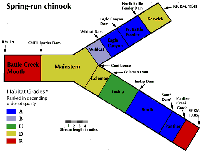 Click on image to enlarge (34K).
Click on image to enlarge (34K).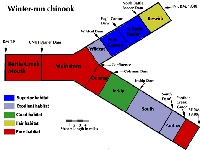 Click on image to enlarge (35K).
Click on image to enlarge (35K).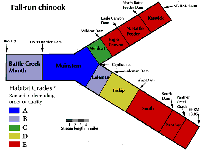 Click on image to enlarge (34K).
Click on image to enlarge (34K).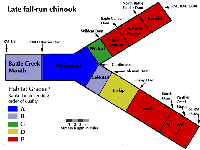 Click on image to enlarge (34K).
Click on image to enlarge (34K).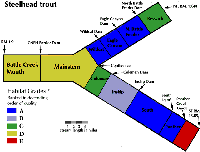 Click on image to enlarge (34K).
Click on image to enlarge (34K).
To learn more about this topic click Info Links
To view additional information (data source, aquisition date etc.) about this page, click Metadata
| www.krisweb.com |
